Delicate food: the history of the emergence of sanitary pads and tampons
Categories: Health and Medicine | Society
By Pictolic https://pictolic.com/article/delicate-food-the-history-of-the-emergence-of-sanitary-pads-and-tampons.htmlKotex is the most popular in the United States brand, producing women's sanitary pads. Today, thanks to advertising, it's hard to find someone who would not know the products of this company. But it was not always the word Kotex has long been a code for women and its value is carefully guarded from men.

What was the reason for this attitude to the important products for women, without which one cannot do? Surprisingly, the blame does not female modesty, and... the men themselves. For many years century, the Church and even the official science was taught all around that critical days in women is a bad thing.
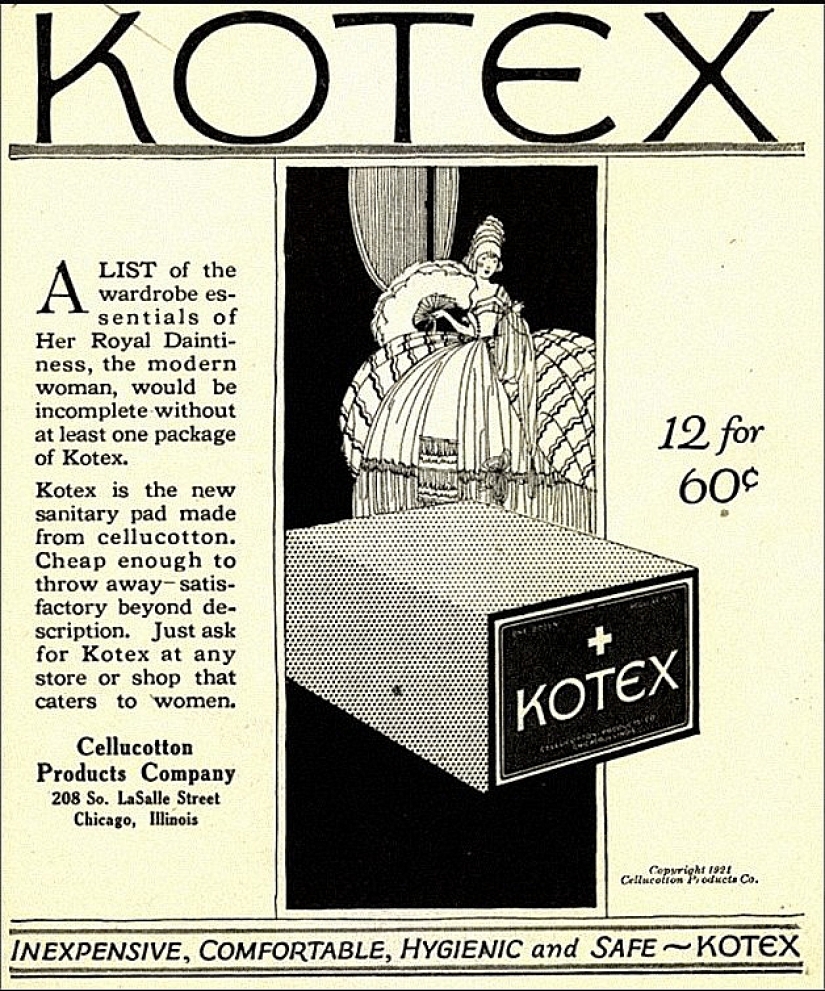
The first advertisement for Kotex products, 1921, USA
In 1868, Vice-President of the American medical Association has stated from the pulpit of his organization, that female doctors can't be trusted during their regular "malaise." In 1872, an American scientist and physician Edward Clarke expressed his point of view, implying that the Schoolgirls and female students should not attend classes in "special days", since due to high load on the body they are unable to think.
This well-known writer and feminist Eliza Duffy Clark answered a question why in this case you don't take women from the heavy work and household chores if their body is in such serious stress? Or Mr. Clark's hiding something and is depriving Americans of the right to education?
It's just two facts, but in fact, such applications were many and they came from the authoritative men around the world. Is it any wonder now that women are struggling to hide their condition from others.
Tampons have a very long history. In Africa they were made of herbs, in Japan from rice paper in Egypt from papyrus, and Ancient Rome from the wool. For a long time was distributed very dangerous to health and even life method of application of these hygiene products, which after use, washed and again allowed to move.
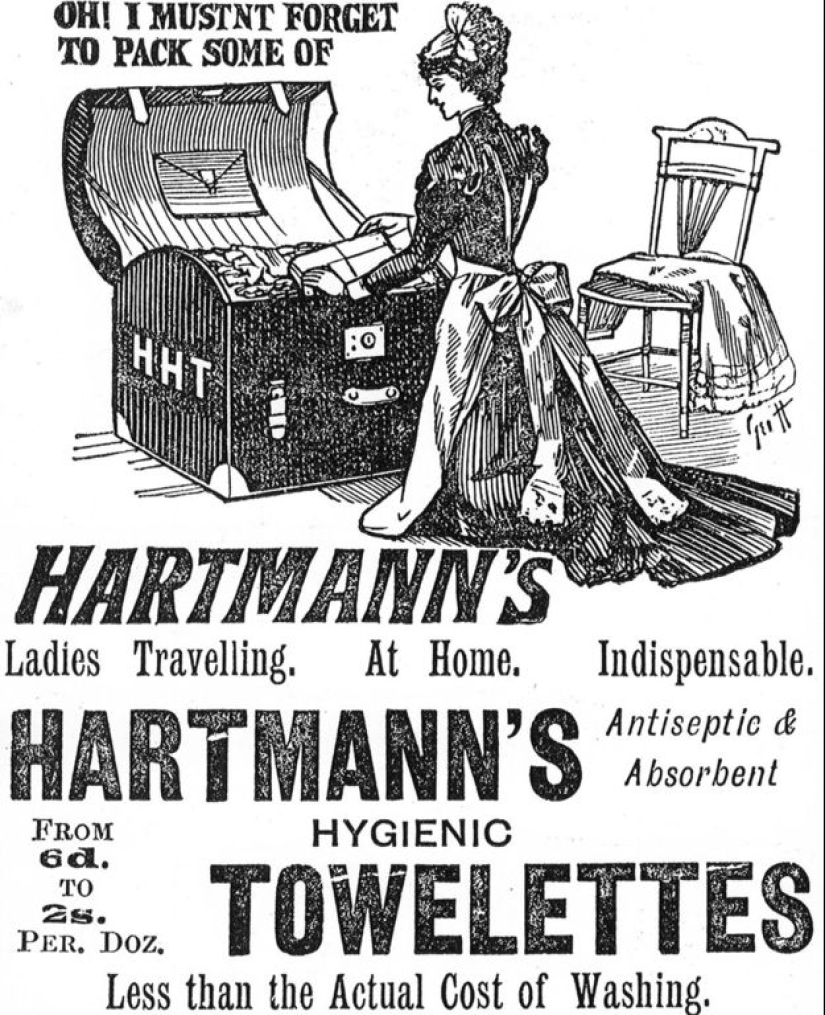
Advertising sanitary napkins Hartmann, end of XIX century
We now know that this approach to health is fraught with dangerous infections, and even cancer. In spite of this to begin commercial production of disposable products in no hurry, even in the most advanced countries.
In the middle of XIX century, the development of the industry has resulted in the production of many foods and hygiene goods were put on stream. But special items for the ladies is not touched. The reason lay in the fact that nobody knew how to sell them, because to talk in society about women's physiology was not accepted, and therefore it was impossible to run the ads.
The first official attempt to sell sanitary napkins refers to 1895. In one of the London Department stores appeared "wipes" from the German company Hartmann. In 1896, Johnson & Johnson put on the market products called "Strip Lister". Your name strips gave the British surgeon Joseph Lister, who taught physicians around the world to sterilize tools.
But these desired goods are not produced the expected effect and were adopted by the target audience is pretty cool. It is possible that it was affected by the centuries-old tradition out of the situation using the means at hand, or again played the role of female modesty.
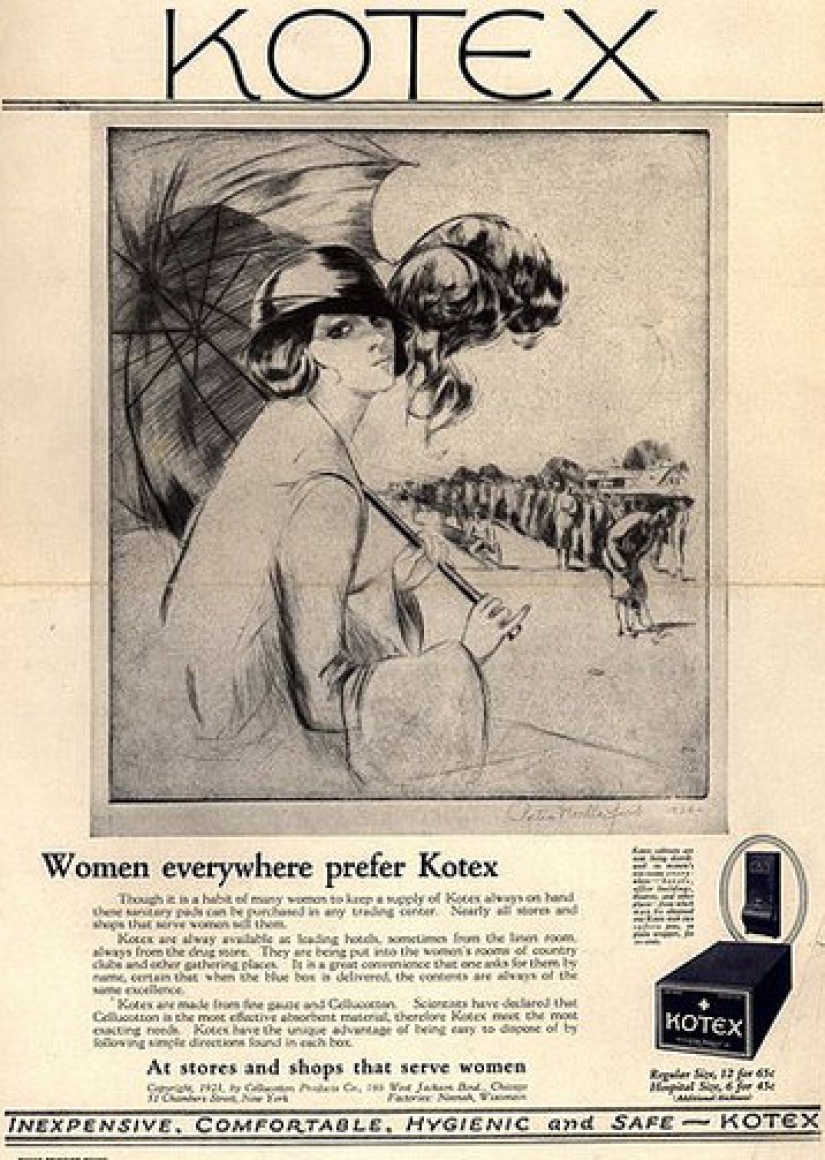
Advertising of products Kotex, 1920-ies, USA
A real breakthrough in this field was made during the First world war, when the Kimberly-Clark company began producing dressings on the basis of crepe paper. This new material made from wood pulp, which was cheaper than cotton and superior to its hygroscopic properties.
By the end of the war, the demand for bandages fell sharply and Kimberly-Clark began to look for new markets. Just at this time in the company's office received a letter from the nurses thanking them for quality products. Women wrote that I use for dressings of crepe paper for hygienic purposes and very happy with the result.
It looked promising, but there was already a sad experience of Hartmann and Johnson & Johnson , which only suffered losses on the new product. However, Kimberly-Clark decided to risk it and began to produce products with mysterious name Kotex.
The name is composed from the words "cotton" and "texture" and it became a code in women's conversations. Hearing the word "koteks", the man did not understand what was going on and it is possible to avoid awkward situations. "Though someone explained to me what a Kotex!" — angrily threw one of the young men during a dinner party in 1920. Needless to say that room full of ladies just gently smiled in response.
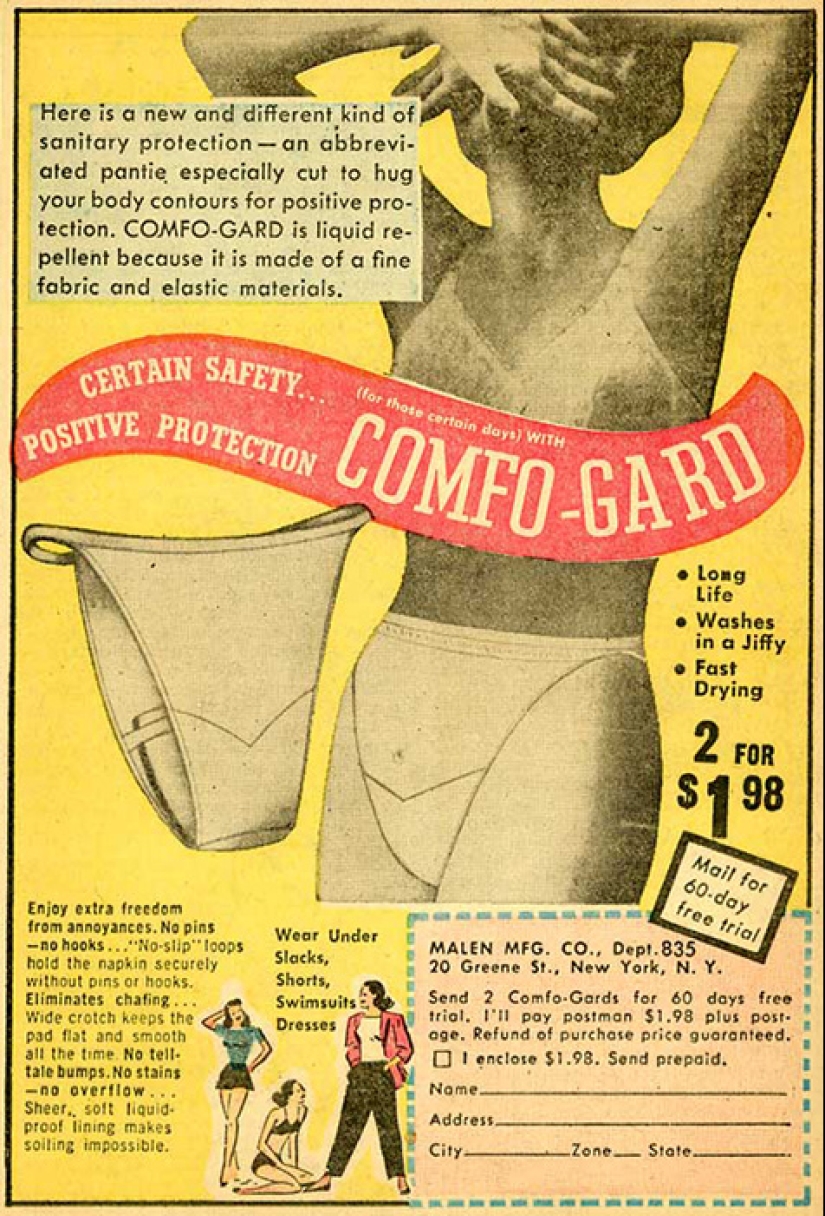
In the mid-twentieth century was used here are hygienic belt
New goods rapidly began to gain popularity. It helped a lot that women after the First world war became more active. They engaged in social activities and science, worked in factories and traveled a lot. Kotex is solved their problems and the brand flourished.
American psychologist and expert in the field of management Lilian Gilbret in 1927, conducted a study of the market hygiene products for women and praised the development of Kimberly-Clark. She noted that the product is disposable in a compact package — a real godsend for modern women leading an active lifestyle.
By the early 30-ies of the unspoken ban on talking about hygiene disappeared and the appointment Kotex spoke openly. Advertising pads were everywhere and it was kind of annoying to some men. For example, Nobel prize winner writer William Faulkner wrote about it:
Is not this the best proof that the secret product is firmly established in people's lives?
In 1933, in addition to strips of crepe paper on sale there is patented under the brand name Tampax tampons. In 1937, the list of hygiene products for women updated again — started production of the menstrual caps, invented by Leon Watson Chalmers.
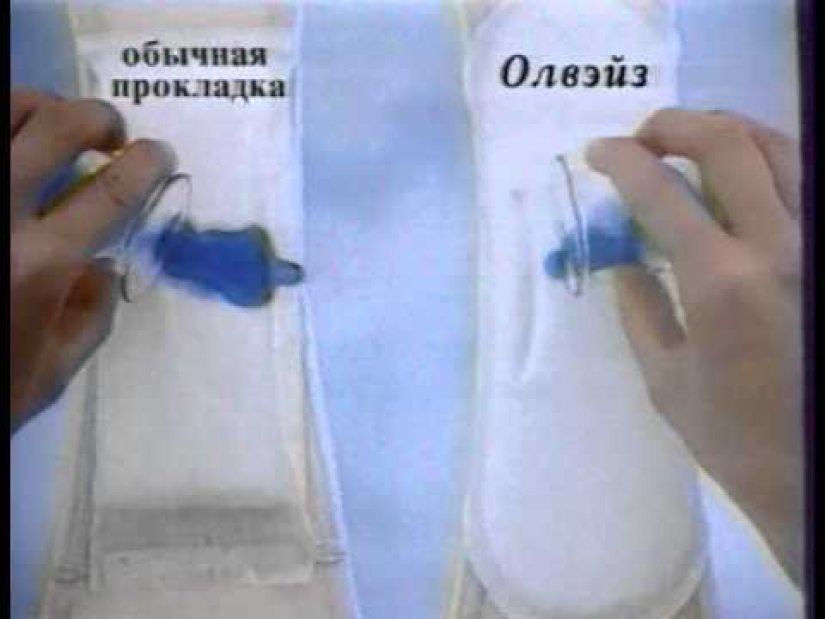
Then came the Second world war and in the advertising for women has a new motive. Now they serve them to consumers as a way for women to maximally mobilize for the benefit of the homeland. One of the Kotex advertisements of the time portrays a girl who threw a MOP and a broom on the floor. The inscription on the poster reads:
Later is became more evident, although to many it looked like fun. A lot of jokes spawned a video in which a sanitary pad, spreading the "blue blood", and this process is closely watched by scientists in white coats. An important attribute of these videos were also women in white shorts, pants or bathing suits that rode, ran and rode bikes.
Now hygiene products for women only in USA sold 3 billion dollars a year. Interestingly, in this industry always played a large role men. In addition to the managers of Kimberly-Clark, the majority of whom were men, as an example, is called Arunachalam of Muruganantham.

The Indian guy, not having even completed secondary education, conceived to solve the global problem of women in her country, namely providing them with quality sanitary pads. In 1998, he told his wife he doesn't want her used dirty rags. "I would that even your moped is not wiped," said Arunachalam and he began to construct a machine for the production of gaskets.
Women from the family innovator did not appreciate his inventive ardor. First, from the Indian left his wife Shanti, and then he stopped to chat even his own mother. In their opinion, the occupation Arunachalam was a disgrace for men, and that he was crazy and a pervert.
But determined the man did not give up and eventually succeeded. Now he is more than successful and respected, and his wife returned to share the triumph of her husband. About the inventor in 2013 made a documentary film with the strange name of "Menstruating men" (Menstrual Man).
But India is not the only country in the world where stigmation everything related to critical days. According to the statistics of UNESCO in sub-Equatorial Africa, one girl out of ten miss lessons at school because of menstruation. It all happens the way I wanted Dr. Edward Clark and this is not good.

Absenteeism lead to the fact that girls lag behind in educational material and it often becomes the reason for complete refusal to attend school. And it's not only reprehensible in relation to a completely normal physiological state of the female body, but in the absence of special conditions. In African schools it is difficult to meet lockable showers, and sometimes not even running water.
Plays a role that many women cannot afford to purchase hygiene products. Arunachalam of Muruganantham helping to solve the problem in India, says sadly that what in the West is considered a normal product that was bought almost without thinking, in his country, millions of women consider luxuries.
In most countries, women's hygiene, though not considered a popular subject for mass debate, but, at least, is already out from the category of taboo. Women in all relationships are trying to ensure equal rights and opportunities, for example, introducing a ladies ' urinals.
Keywords: Hygiene | Women | Care | Invention | Scientists | Physiology | School
Post News ArticleRecent articles

Historically, it was men who were considered fetishists, but, it turns out, representatives of the fair sex also have their own ...

The Falkirk Wheel is located near the city of Falkirk (thanks to it, it got its name). This super-weapon is unique in its kind. The ...
Related articles

Historically, it was men who were considered fetishists, but, it turns out, representatives of the fair sex also have their own ...

Sex is an integral part of life. The body actively reacts to the sensations that arise during lovemaking, and this happens in ...

We have already told you the incredible story of photographer Mihaela Noroc from Romania, who quit her job, withdrew her savings ...

The world around us is constantly being transformed, so is it any wonder that the attitude of the law to some things and actions ...